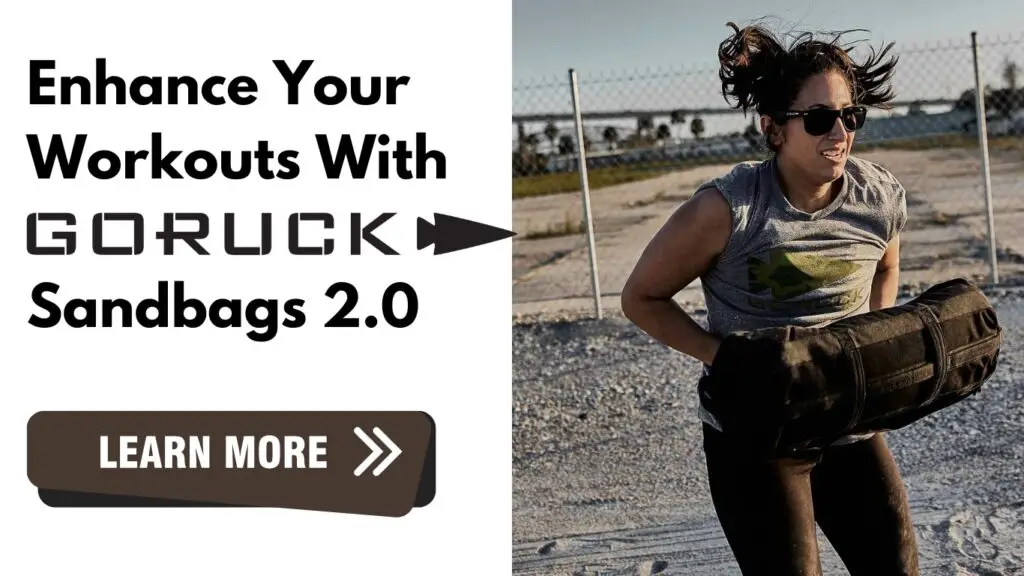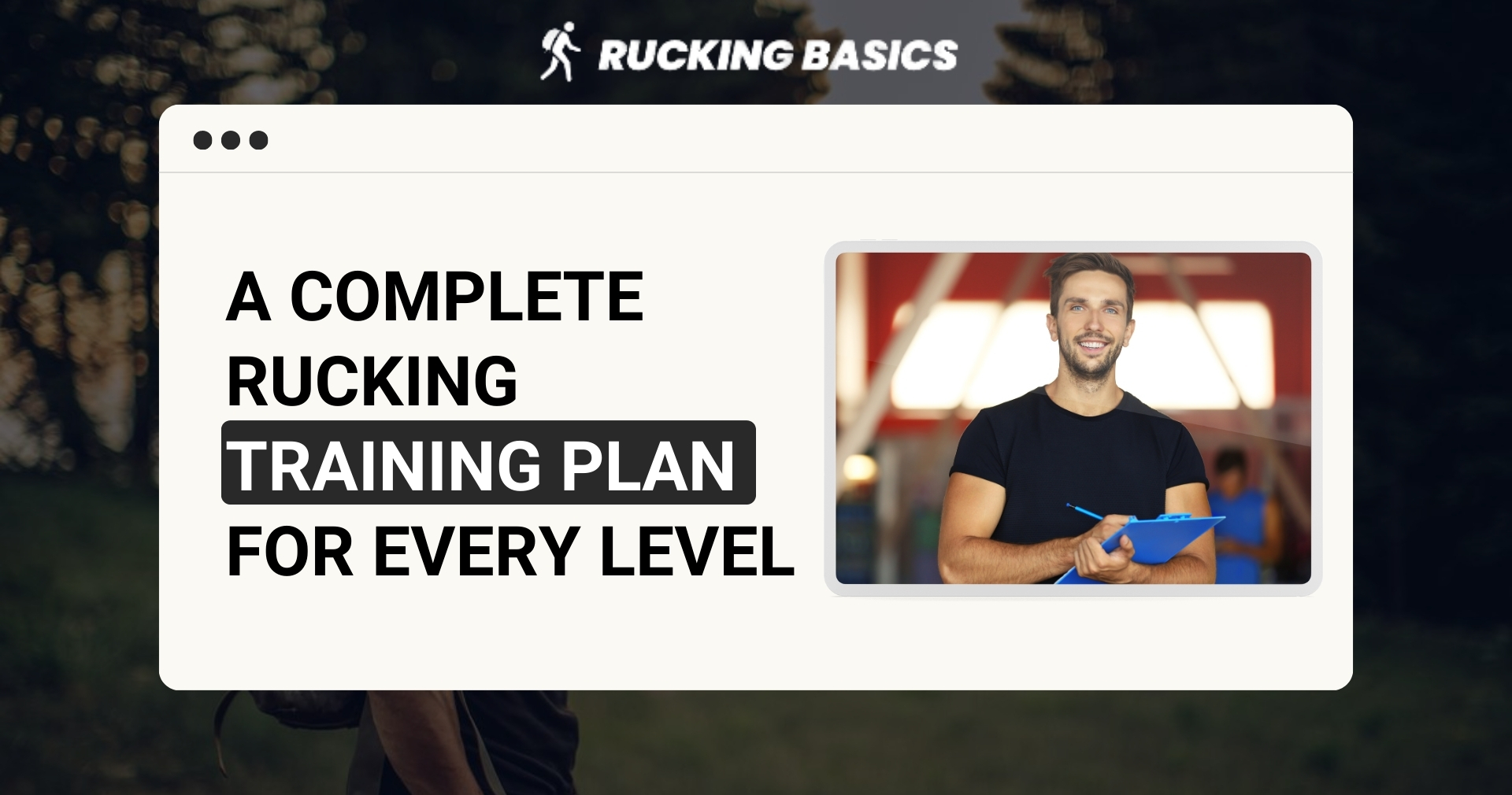You need to follow the rucking training plan in order to be successful. I’m not talking about winning competitions but enjoying this activity to the maximum and reaping all the benefits.
Rucking is not backpacking—the primary goal is not just to enjoy nature and travel but to gain health benefits, including weight loss.
You’ve probably seen the GORUCK Tough Training Plan, and we’ve prepared several training regimens so you can find the right one for you, whether you started to ruck a week ago or three years ago.
Along with detailed training plans for beginners, intermediate, and advanced ruckers, this comprehensive guide by RuckingBasics will provide other essential information as well, such as complementary strength training, muscles worked, and the energy systems involved in rucking.
Beginner Rucking Training Plan
Being a beginner in rucking is much easier than in some other activities or sports. Rucking is a simple form of exercise, so the learning curve will not be a problem, like when you start tennis or basketball.
If you’re looking for extra guidance, some excellent books on rucking can help you master the basics and set you on the right path.
As a beginner, it’s natural to feel like you’re lagging behind seasoned ruckers in terms of strength and endurance. However, with dedication, you have the potential to bridge this gap. During the initial one or two months, it’s crucial to strike a balance between exertion and rest, thereby preventing burnout and injury.
Understanding Your Starting Point
Being a beginner in rucking does not mean your fitness level is low. Maybe you are in perfect shape, which will certainly help, although you will not be able to translate it to rucking 100%. So, first, assess your current fitness level and set realistic goals.
Understanding your starting point helps tailor your ruck training plan. Don’t overestimate your capabilities. Just because you can ride a bike for hours does not mean that you will immediately be able to have the same success in rucking. Every type of skill and fitness is very sport-specific. A marathon runner cannot play tennis for four hours and vice versa.
Set both short-term and long-term goals to stay motivated. Short-term goals include completing a certain distance or increasing weight, while long-term goals involve tackling more challenging terrain.
Weekly Training Schedule
Let’s divide the training schedule into two parts over two months. In my experience, it is the most effective approach.
Week 1-4: Building a Base
Start with light weights (10-15 pounds) and short distances (1-2 miles). Aim to ruck 2-3 times per week, gradually increasing the duration as your body adapts. Track your time per mile. This is helpful for several reasons.
First, you can see whether you are progressing or stagnating. If you’re making progress, keep going; if you’re stagnating, try to work on the mental aspect as well.
If you’re regressing, you’re probably tired and need to rest, plus improve your entire recovery routine. You need a smartwatch because it will measure your time, pulse, distance, and everything else.
Week 5-8: Increasing Load and Distance
Increase your ruck weight by 5 pounds and aim for longer distances (2-3 miles). If you feel comfortable, add an extra rucking day to your week while maintaining a steady, manageable pace.
Don’t be disappointed if you’re not progressing as fast as you’d like. The body is complex, and on top of that, you probably have a lot of other responsibilities. Your day revolves around something other than preparing for rucking. So, it is entirely possible that stressful work and problems with children can derail you.
Don’t give up; keep going. It is important to progress and not regress, even if it is baby steps. Don’t forget that stagnation can be a sign of a plateau.
Intermediate Rucking Training Plan
A few of the very advanced beginners will be able to reach this stage quickly. My friend, who is otherwise a semi-professional athlete, immediately started with this intermediate rucking training plan.
But that is the exception, rather than the rule, so in most cases, you will be here in around two months.
Evaluating Progress from the Beginner Stage
There will be better and worse days. Don’t rely on time and millage when you are slowest and fastest. Review your distance, weight, and overall endurance on average days.
Then, you will have a realistic impression of how much you have progressed from the beginner stage. I will give you general guidelines and your data will help you determine exactly how much to increase weight and distance and whether it is time to introduce elevation into your routes.
Weekly Training Schedule
Again, this phase usually lasts eight to ten weeks if you don’t skip workouts. If you do, you can stay in the intermediate phase for months, which is not bad per se.
Many ruckers do not intend to become advanced and can forever reap benefits out of this stage, with minor tweaks every now and then.
Week 1-4: Building Endurance
Increase your ruck weight to 15-20 pounds and extend your distances to 3-4 miles. Now, we are aiming to make your rucking backpack heavy.
Ruck 3-4 times weekly, incorporating varied terrains to build endurance. Since you probably won’t have time to go to the trails four times a week, feel free to also integrate urban rucking.
If you’re considering upgrading your gear to handle these new demands, the GORUCK Rucker 4.0 is a great choice. It’s designed for serious ruckers, offering durability, comfort, and an ergonomic fit to support your progress as you increase weight and distance.
Week 5-8: Enhancing Strength and Speed
It’s time for interval training with your rucksack. Alternate between brisk walking and slower recovery paces — like high-intensity interval training (HIIT) but adjusted to rucking. Add hill workouts to strengthen your legs and improve cardiovascular fitness.
Maintain a focus on recovery with activities like foam rolling, stretching, massage, and healthy nutrition.
Advanced Rucking Training Plan
Congratulations, you belong to the very exclusive group of elite ruckers. Your rucking workout is at the top level now, so it’s time to find out what you need to do to stay in the perfect shape and improve further.
Setting Advanced Performance Goals
I advised you to temper your expectations in the beginner and intermediate stages. Now is the time to set ambitious goals, such as participating in rucking events or completing long-distance rucks with heavy weights.
You cannot reach the advanced phase by chance — you have proven your commitment to rucking.
Week 1-4: Peak Performance Preparation
Increase your ruck weight to 25-30 pounds and aim for distances of 5-6 miles. Incorporate high-intensity interval training (HIIT) sessions to enhance speed and endurance.
Week 5-8: Specialized Rucking Techniques
Focus on specialized techniques such as speed rucking, where you aim to cover a set distance as quickly as possible. You can also try rucking in bad weather to prepare for various conditions.
For example, rucking during colder months is a fantastic way to challenge yourself while also gaining unique endurance benefits. However, it requires proper preparation and gear. To ensure you stay safe and comfortable, explore essential tips for rucking in cold weather. Don’t let a little frostbite scare you off—cold weather rucking can toughen your spirit and your body!
I’m not saying you should ruck during a storm, but you should definitely experience poor weather conditions before a ruck event. That experience can be the difference between completing a ruck march in variable weather and giving up halfway through.
More than ever, you will need advanced recovery techniques such as sports massage, ice baths, and active recovery workouts. Your body is under great stress now, and you have to pay close attention to its signals to prevent overtraining. Otherwise, you risk a prolonged break.
Muscles and Systems Involved in Rucking
Before we move on to the complementary workouts you need, it is important to discuss the muscles and systems involved in rucking.
Once you understand which muscles and systems propel rucking, you will know how to adjust rucking workouts for maximum effectiveness.
Key Muscle Groups
We already covered “What Muscles Does Rucking Work?” so if you want to go into details, read that article. Here, I will briefly mention the main muscle groups to help you get a better idea of what I am talking about.
Legs
Rucking will significantly strengthen your quadriceps, hamstrings, and calves. These muscles power your strides and support the additional weight of the rucksack.
The quadriceps extend the knee and stabilize your movement, while the hamstrings assist in knee flexion and hip extension. The calves, specifically the gastrocnemius and soleus, make you move forward by facilitating ankle flexion and extension.
Therefore, strengthening these muscles improves your ability to handle longer distances and heavier loads, enhancing overall rucking performance.
Core
A strong core, including the abdominals and lower back, stabilizes your body and maintains proper posture while carrying a weighted backpack.
The core muscles—the rectus abdominis, obliques, and erector spinae—provide the support to keep the torso upright and balanced.
If you’re looking to maximize core strength during your rucks, check out this guide on rucking abs. It offers helpful tips for better posture and engaging your core effectively while rucking.
The core prevents excessive leaning or swaying and aids in transferring power from the lower body to the upper body, an often-overlooked role of the core.
Upper Body
The upper body is significantly less involved than the lower body and core, but it is still important.
The shoulders and upper back muscles support the weight of the rucksack. The trapezius, rhomboids, latissimus dorsi, biceps, deltoids, and all other muscles stabilize the shoulder girdle, maintain alignment, and distribute the load evenly.
Energy Systems
The human body has different mechanisms for producing energy.
The three primary energy pathways are phosphagen (ATP-PC), glycolytic, and oxidative. Although many believe that the body uses them alternately, they are actually active constantly. Yet, different energy pathways take the front set in different situations, and the other two are secondary.
Aerobic System for Endurance
Rucking relies heavily on the aerobic energy system, which uses oxygen to convert carbohydrates and fats into energy.
This system supports sustained, moderate-intensity activity, which is precisely what rucking is most of the time. Thanks to it, you can keep a steady pace over long distances.
Anaerobic System for Short Bursts
While primarily aerobic, rucking also engages the anaerobic system during short bursts of high-intensity effort, such as climbing hills or quickening your pace.
The anaerobic system breaks down glucose without oxygen to produce energy quickly, supporting short, intense efforts.
Cardiovascular System
The cardiovascular system is key not only for rucking but also for a long and healthy life.
Heart and Lung Health
Rucking improves heart and lung health by increasing cardiovascular efficiency.
Regular rucking sessions strengthen the heart muscle, making it more effective at pumping blood. Over time, it will lower your resting heart rate and reduce the risk of cardiovascular diseases. Rucking as aerobic training also enhances lung capacity.
How does all of this affect rucking exactly? Your endurance and overall physical performance will go up once your body becomes better at delivering oxygen to working muscles.
Complementary Workouts
I told you before that practically everything in strength and conditioning is sport-specific, and you cannot translate much from one activity to another.
That is undoubtedly true. However, every sport and activity need complementary workouts to prevent injuries, improve performance, and change the routine a bit to avoid monotony.
Strength Training for Rucking
You have to design a strength training routine that complements your rucking schedule. Aiming for 2-3 strength sessions per week is optimal, but I know it can be challenging for multiple reasons.
First, that would mean you should ruck or go to the gym practically daily. That is too much because your recovery will suffer, and you will not progress. Second, all other obligations prevent you from spending at least an hour every day on sports activities.
So, you have to find a balance. If you are short on time, do two weekly strength workouts, focusing on compound movements that build overall strength. For example, you can do a basic push-pull split. Also, perform functional exercises using your bodyweight, a kettlebell, or sandbag.

Or you can follow sports methodology and divide the year into several parts, such as pre-season, in-season, post-season, etc., similar to professional sports. Then, determine the period when your gym will be primary and ruck complementary. That way, you can plan peak performance for ruck during a part of the year when there is an event or when you have the most time to hit the trail.
Whatever approach you choose, exercises like squats, deadlifts, lunges, bench press, shoulder press, and pull-ups must be part of your rucking routine. Isolation exercises can also be helpful, but do them if you have time. Don’t base your trainings on them because your goal is not hypertrophy and a bodybuilding look.
Cardiovascular Training
Running, cycling, and swimming, while not the sole contributors to rucking performance enhancement, play a role in improving cardiovascular endurance. Incorporating these activities into your rucking training program can significantly boost your overall performance.
If you’re looking for a low-impact alternative, consider rucking on a treadmill. This method allows you to simulate an outdoor rucking program while reducing the risk of strain on your joints, especially during recovery phases or poor weather conditions.
I find it very beneficial to sprint for 1 minute, then walk or jog for 2 minutes, and repeat for 20-30 minutes. This approach is called long HIIT which is similar to what you can do the same in the pool, only with a shorter duration.
Steady-state cardio builds aerobic stamina. Nevertheless, I haven’t noticed a significant improvement in ruck performance after regular aerobic exercise, so I advise using it more as a cool-down routine.
Flexibility and Mobility
Stretching routines are good for improving flexibility and preventing muscle tightness and should be a part of your rucking workout plan. Do dynamic stretches before rucking and static stretches afterward. On a rest day, do dynamic ones first to warm up and then static stretches.
Mobility is more important than flexibility, so drills like hip openers, ankle mobility exercises, and thoracic spine rotations are a must for me and my clients. A good range of motion (ROM) improves movement efficiency during rucking.
Nutrition and Hydration for Rucking
Vigorous training and performance improvements are impossible without proper nutrition and hydration.
Yes, someone will give you an example of a world-class athlete who achieved terrific results while eating junk food. Remember, that is one case in a million and is not applicable to regular people like us. Elite athletes make up less than 0.01% of the world’s population.
So, let’s see what you should eat before, during, and after ruck sessions.
Pre-Ruck Nutrition
It depends on the length of the ruck, whether it is a competition or training, and so on. As a general rule of thumb, consume a balanced meal around 2 hours before rucking, focusing on complex carbohydrates, lean proteins, and healthy fats.
Complex carbohydrates are better than simple ones for rucking because it is an activity that lasts a long time, so you need a sustained energy level. Avoid heavy, greasy foods that can cause digestive issues during your ruck. Although high-calorie food may seem like a good idea, it usually isn’t (if the source is junk food.)
To get an additional energy boost, eat a light snack, such as a banana, a handful of nuts, or an energy bar, about 30 minutes before rucking.
And hydrate yourself in the hours leading up to the activity.
During Ruck Nutrition
Energy bars, dried fruit, and similar items are light, energy-boosting snacks you should have with you. These snacks provide quick energy during long rucks without burdening the stomach since they are small portions.
Sip water every 15-20 minutes to maintain hydration levels. Consider using a hydration bladder for easy access to fluids. In hot weather or during intense sessions, use sports drinks to replace lost minerals and prevent cramps.
Post-Ruck Recovery Nutrition
You don’t have to chase the supposedly magical anabolic window because it doesn’t really exist. Nevertheless, strive to consume a rich meal within an hour or two after completing your ruck to support recovery.
I like to wait around 2 hours for hunger to kick in. This meal should include a good mix of protein and carbohydrates to replenish glycogen stores and repair muscle tissue. Also, feel free to eat something you like with a balanced meal, even if it’s not perfectly healthy. Mental recovery is essential, and comfort food helps.
Antioxidant-rich fruits and vegetables like berries are also recommended to reduce inflammation and aid recovery. In theory, these foods help mitigate muscle soreness and speed up healing. Even if they don’t help with that significantly, they are still very healthy overall.
Avoiding Common Injuries
We all know by now that rucking is an excellent workout that combines cardiovascular endurance and strength training. However, as with any physical activity, there is a risk of injury. And that risk increases if proper precautions are not taken.
Rucking is more taxing than walking and less taxing than running.
Some of the most frequent rucking injuries are:
- Shoulder Problems: Carrying a heavy rucksack is not easy for the shoulder muscles and joints. Poorly adjusted straps, uneven weight distribution, and excessive ruck weight can cause pain and sometimes injury. Properly fitting rucksack, regular strength training, and suitable weight (including mindful weight increase) should prevent such problems.
- Low Back Pain: Rucking is not bad for your back, but chances are that at some point, you will experience the most common type of pain—low back pain (LBP). Poor posture, weak core muscles, and improper lifting techniques can contribute to this issue, but sometimes LBP just appears out of the blue. Keep doing exercise and stretching, and things will improve soon. For a different approach to training, you might try rucking at night as well. It can introduce new elements to your workout, with cooler temperatures and a quieter setting that may help you focus on your form.
- Knee Pain: Knees are often sensitive and cause problems in many sports. Strong quads will not be enough since rucking places massive stress on the knee joints. You have to buy suitable rucking shoes or rucking boots. Consider insoles as well and warm up adequately.
- Foot and Ankle Injuries: Sprains and blisters are almost inevitable. Shoes are again most important for comfort and support. Buy moisture-wicking socks to reduce the risk of blisters, and use specialized plasters.
GORUCK Ballistic Trainers
For use with barbells, sandbags, and all the things that make you strong. The most versatile and functional shoes for training in the real world.

It is possible to feel pain in other parts of the body; for example, the hip, neck, and arms are common places. Similar advice applies to all of this, and if the problem is prolonged, consult your doctor.
Wrapping Up
The rucking lifestyle demands patience and consistency from you. The Marine Corps, Air Force, and other special forces are working on mental toughness equally as on aerobic capacity and strength.
You won’t make miraculous progress overnight, but many miles and workouts are needed before reaching certain achievements. That’s why we encourage you to celebrate small achievements along the way.
Remember that every step forward brings you closer to your goals. Also, keep in mind that rucking has no finish line; it is a lifelong journey you should enjoy, and it will help you be healthy and functional even in the old age.
Whether you’re a rookie or a pro, rucking offers endless opportunities for growth, strength, and resilience.
Frequently Asked Questions
How can I determine the right ruck weight for my fitness level?
If you’re a beginner, start with 10-15% of your body weight. Then, gradually increase the weight (rucking progression) as your strength and endurance improve. If you feel ready, add about 5 pounds every few weeks or more, but don’t overdo it.
What are some advanced rucking techniques for increasing speed?
You need to work on your strength, conditioning, and mental aspect to ruck faster. Also, it is necessary to improve mobility and flexibility due to injury prevention and more economical movements (improved biomechanics). Food, rest, and gear also play a role.
Are there specific breathing techniques that can enhance rucking performance?
Practice deep, diaphragmatic breathing to enhance oxygen intake and improve endurance. Maintain a steady breathing rhythm, matching your breaths with your steps to stay focused and efficient.
How can I make rucking more enjoyable and less monotonous?
Vary your routes and terrains to keep your ruck training program interesting. Joining a rucking group is always a great idea to make the experience more social. Also, I enjoy listening to podcasts when I ruck alone because they help me forget about fatigue. You can go with music or audiobooks if you prefer them more than podcasts.
Is there any modification to the workout plan to help prepare for a rucking event or competition?
Tailor your training plan to mimic event conditions, such as the distance, terrain, and weight requirements. Gradually increase your training volume and intensity as the event approaches.
What are some signs that I need to adjust my rucking training intensity?
Signs include persistent fatigue, prolonged muscle soreness, and a plateau in performance improvements. If you experience these, consider reducing your weight, distance, or frequency to allow for recovery. There is no progress without rest.
References
Karsten B, Stevens L, Colpus M, Larumbe-Zabala E, Naclerio F. The Effects of a Sport-Specific Maximal Strength and Conditioning Training on Critical Velocity, Anaerobic Running Distance, and 5-km Race Performance. Int J Sports Physiol Perform. 2016 Jan;11(1):80-5. doi: 10.1123/ijspp.2014-0559. Epub 2015 May 6. PMID: 25946163.
Kostikiadis IN, Methenitis S, Tsoukos A, Veligekas P, Terzis G, Bogdanis GC. The Effect of Short-Term Sport-Specific Strength and Conditioning Training on Physical Fitness of Well-Trained Mixed Martial Arts Athletes. J Sports Sci Med. 2018 Aug 14;17(3):348-358. PMID: 30116107; PMCID: PMC6090403.
Midgley AW, McNaughton LR, Jones AM. Training to enhance the physiological determinants of long-distance running performance: can valid recommendations be given to runners and coaches based on current scientific knowledge? Sports Med. 2007;37(10):857-80. doi: 10.2165/00007256-200737100-00003. Erratum in: Sports Med. 2007;37(11):1000. PMID: 17887811.
Ito S. High-intensity interval training for health benefits and care of cardiac diseases – The key to an efficient exercise protocol. World J Cardiol. 2019 Jul 26;11(7):171-188. doi: 10.4330/wjc.v11.i7.171. PMID: 31565193; PMCID: PMC6763680.
Baker JS, McCormick MC, Robergs RA. Interaction among Skeletal Muscle Metabolic Energy Systems during Intense Exercise. J Nutr Metab. 2010;2010:905612. doi: 10.1155/2010/905612. Epub 2010 Dec 6. PMID: 21188163; PMCID: PMC3005844.
Aragon AA, Schoenfeld BJ. Nutrient timing revisited: is there a post-exercise anabolic window? J Int Soc Sports Nutr. 2013 Jan 29;10(1):5. doi: 10.1186/1550-2783-10-5. PMID: 23360586; PMCID: PMC3577439.








